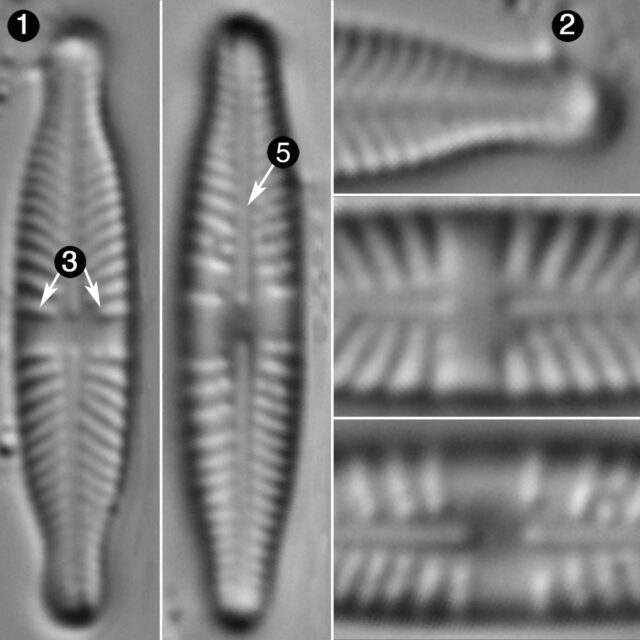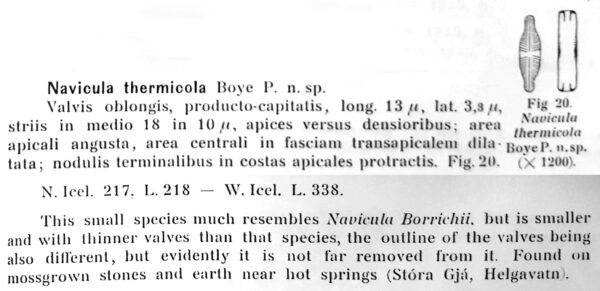Stauroneis thermicola
-
Category
-
Length Range14.2-16.7 µm
-
Width Range2.9-3.6 µm
-
Striae in 10 µm20-28
-
ContributorIan Bishop - Feb 2023
-
ReviewerSarah Spaulding - Feb 2023
Identification
Description
Valves are linear-lanceolate with protracted, subrostrate to capitate rounded ends. A narrow rectangular stauros is present. Striae adjacent to the stauros are parallel, and the rest are curved and radiate throughout the valve, increasing in density from mid-valve to apex. Axial area very narrow, expanding slightly at the central area. The raphe is straight and filiform, with inflated proximal ends. Areolae are coarse near the raphe at mid-valve, but otherwise not visible in LM.
In 2011, Hoffmann et al. took issue with the use of the names Stauroneis thermicola and S. parathermicola for valves in this group exhibiting variability in apical constriction. The authors note that differences in this feature are consistent, and propose the two morphologies be treated interspecifically, not intraspecifically, as has been the case for some time. However, given that the authors cite no evidence for this fact, and several USGS regional stream surveys in the United states have found these morphotypes to co-occur (personal observation), their claim of heterospecificity, at least in North America, is not currently well supported. This page takes a conservative approach until the morphologically variable taxon is further investigated.
Autecology
-
Size Range, µm3
-
Motility
-
Habitat
-
Colony
-
Occurrence
-
Waterbody
-
Distribution
- Learn more about this
Original Description
Navicula thermicola Boye P. n. sp.
Valvis oblongis, producto-capitatis, long. 13 µ, lat. 3,3 µ, striis in medio 18 in 10 µ, apices versus densioribus; area apicali angusta, area centrali in fasciam transapicalem dilatata; nodulis terminalibus in costas apicales protractis. Fig. 20.
-
BasionymNavicula thermicola
-
AuthorJ.B.Petersen 1928
-
Length Range13 µm
-
Width3.3 µm
-
Striae in 10µm18 in the center valve
Citations & Links
Citations
Links
-
Index Nominum Algarum
-
North American Diatom Ecological DatabaseNADED ID: 62040
Cite This Page
Bishop, I. (2023). Stauroneis thermicola. In Diatoms of North America. Retrieved November 21, 2024, from https://diatoms.org/species/stauroneis_thermicola
Responses
The 15 response plots show an environmental variable (x axis) against the relative abundance (y axis) of Stauroneis thermicola from all the stream reaches where it was present. Note that the relative abundance scale is the same on each plot. Explanation of each environmental variable and units are as follows:
ELEVATION = stream reach elevation (meters)
STRAHLER = distribution plot of the Strahler Stream Order
SLOPE = stream reach gradient (degrees)
W1_HALL = an index that is a measure of streamside (riparian) human activity that ranges from 0 - 10, with a value of 0 indicating of minimal disturbance to a value of 10 indicating severe disturbance.
PHSTVL = pH measured in a sealed syringe sample (pH units)
log_COND = log concentration of specific conductivity (µS/cm)
log_PTL = log concentration of total phosphorus (µg/L)
log_NO3 = log concentration of nitrate (µeq/L)
log_DOC = log concentration of dissolved organic carbon (mg/L)
log_SIO2 = log concentration of silicon (mg/L)
log_NA = log concentration of sodium (µeq/L)
log_HCO3 = log concentration of the bicarbonate ion (µeq/L)
EMBED = percent of the stream substrate that is embedded by sand and fine sediment
log_TURBIDITY = log of turbidity, a measure of cloudiness of water, in nephelometric turbidity units (NTU).
DISTOT = an index of total human disturbance in the watershed that ranges from 1 - 100, with a value of 0 indicating of minimal disturbance to a value of 100 indicating severe disturbance.

Stauroneis thermicola
- Variably small, linear-lanceolate
- Apices variably constricted
- Striae adjacent to stauros parallel, all others radiate and curved
- Increasing stria density from mid-valve to apex
- Raphe straight and filiform
Valves linear-lanceolate with protracted, subrostrate to capitate rounded ends. Striae adjacent to the stauros are parallel, and the rest are curved and radiate, increasing in density from mid-valve to apex. Raphe is straight and filiform, with inflated proximal ends.
 Diatoms of North America
Diatoms of North America






